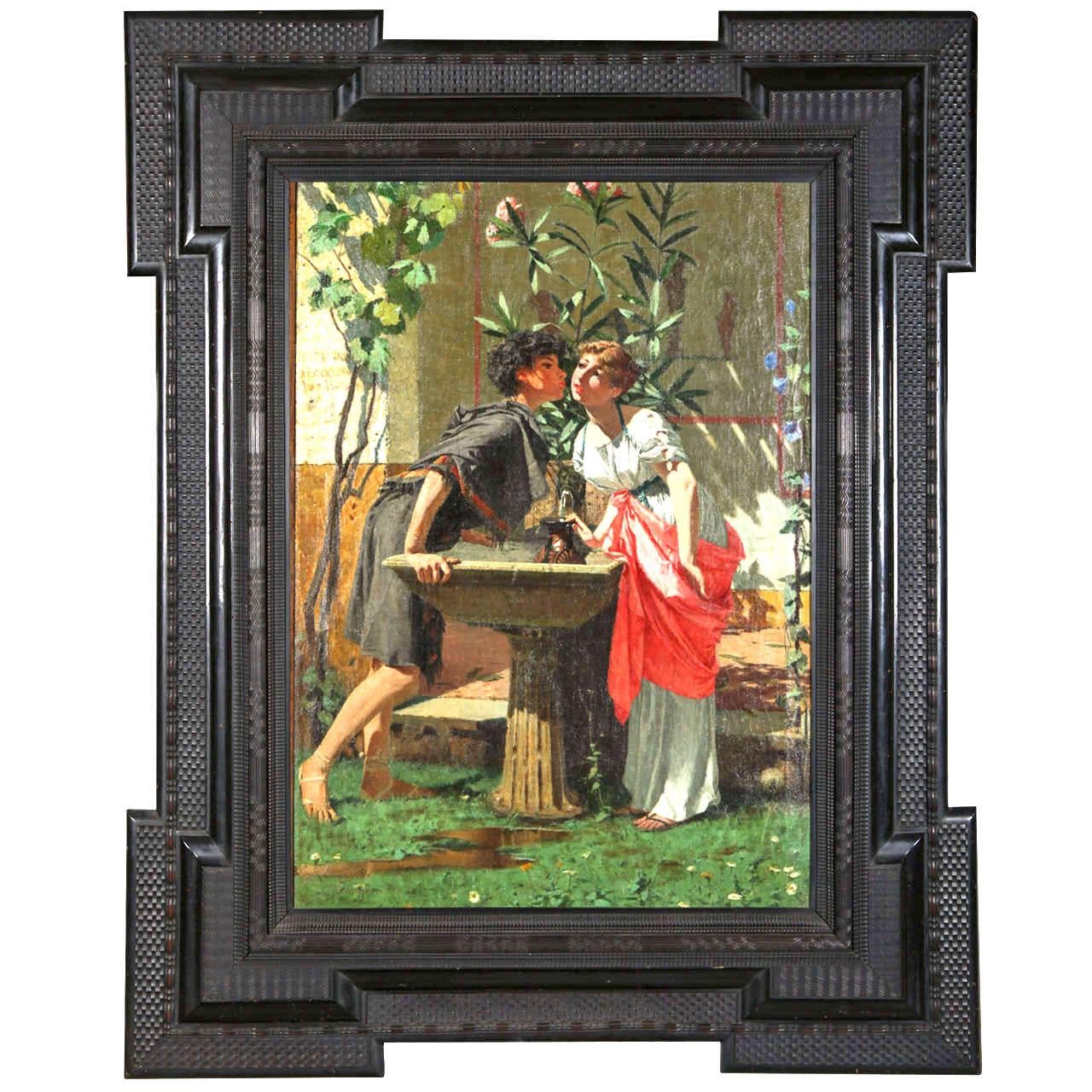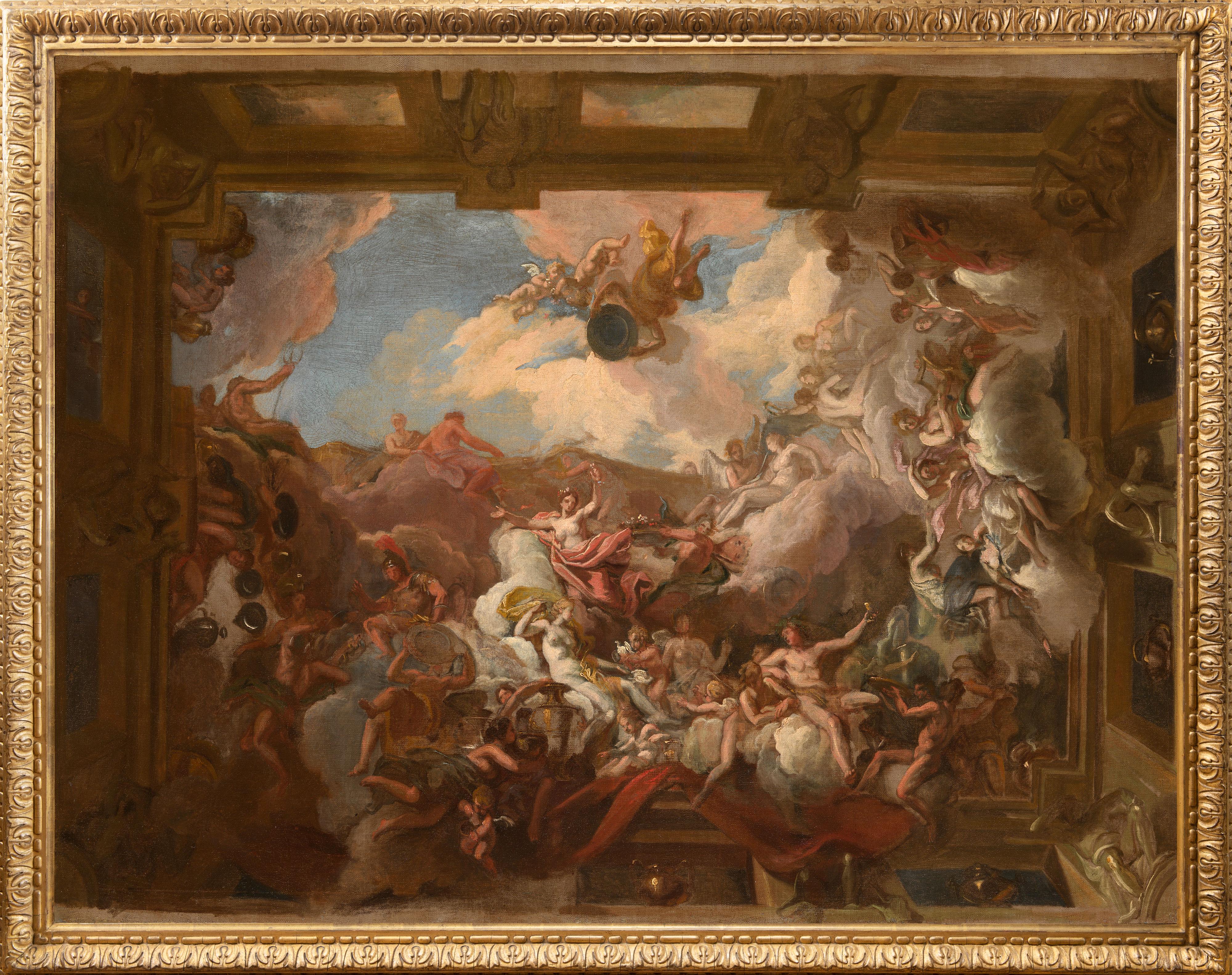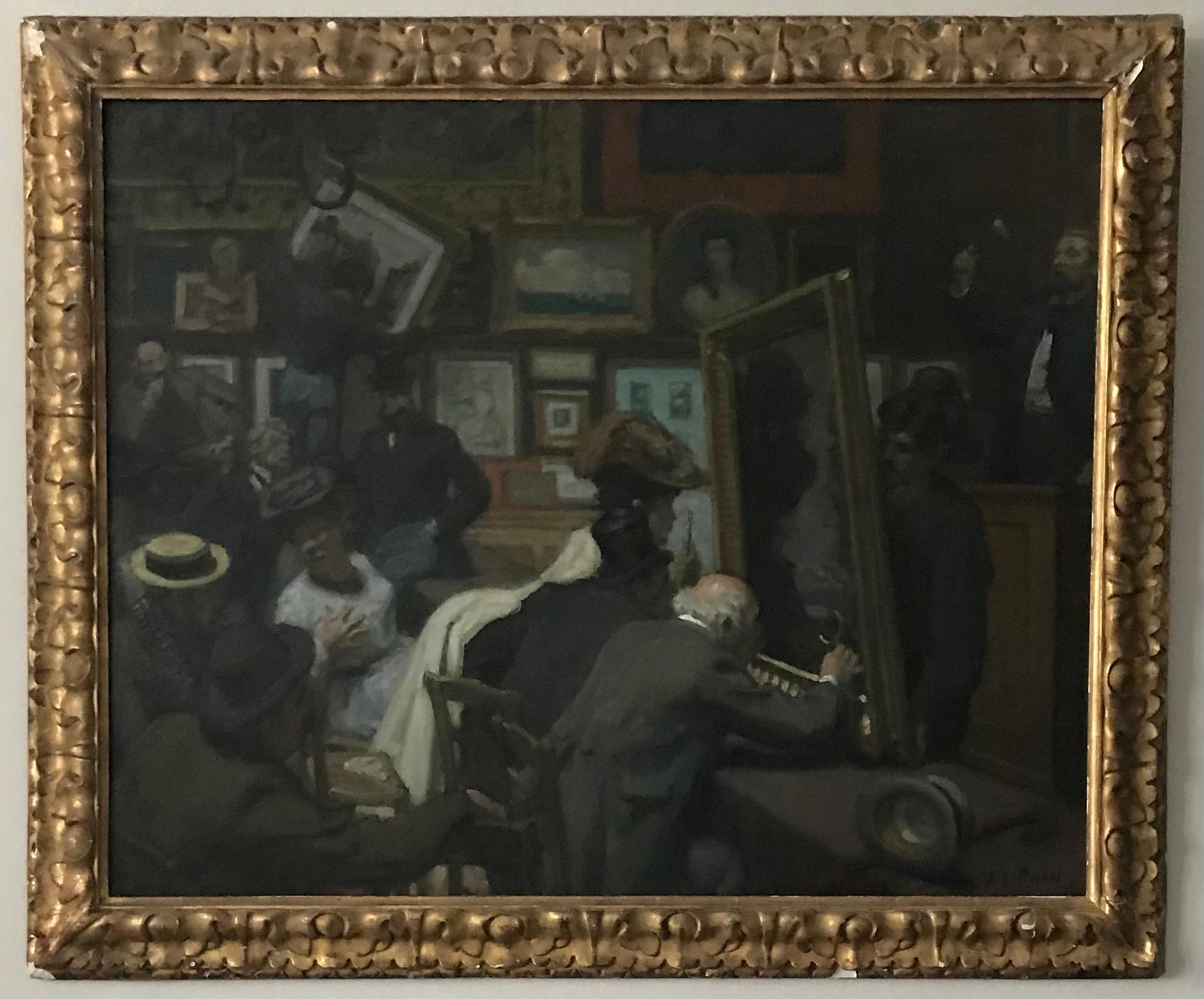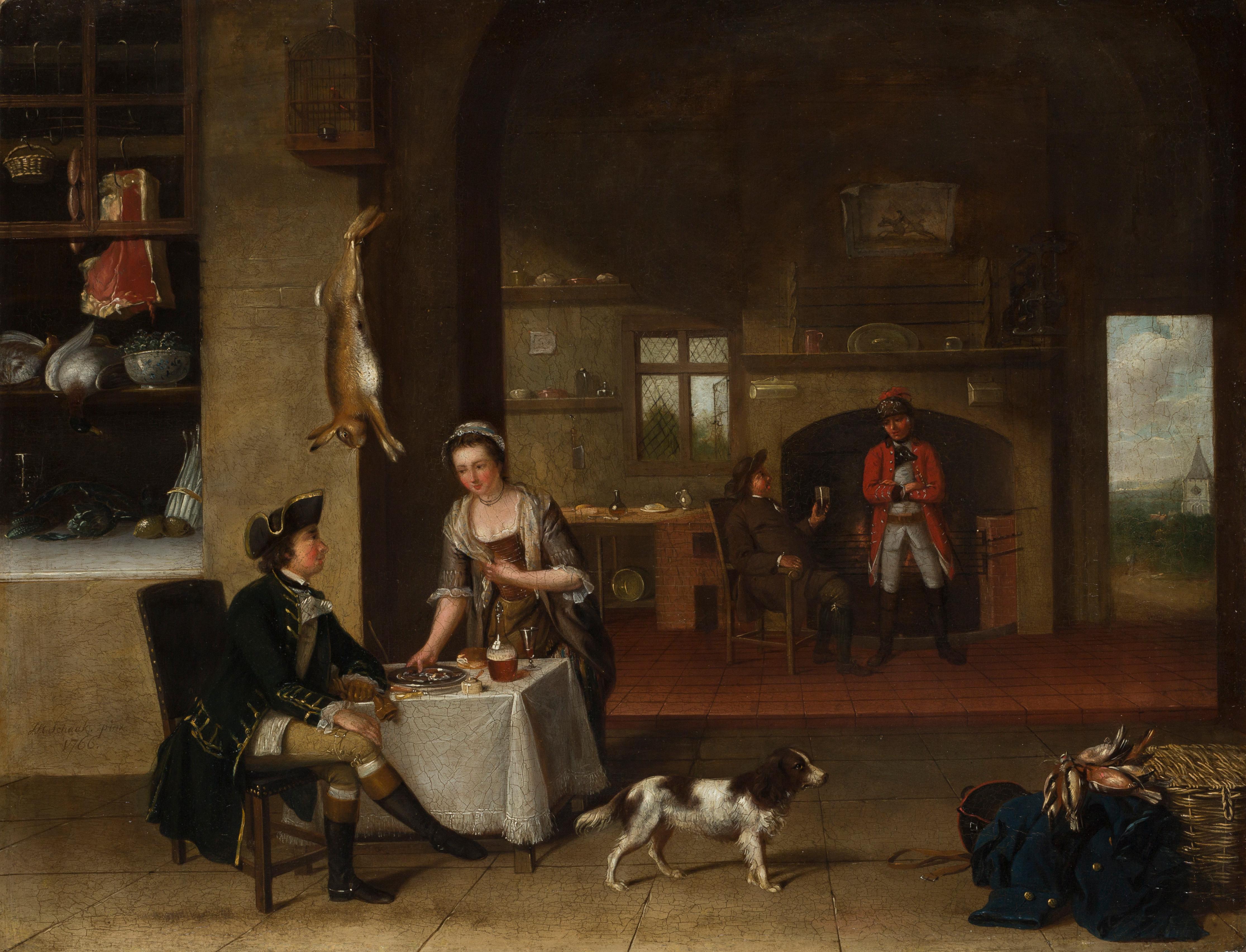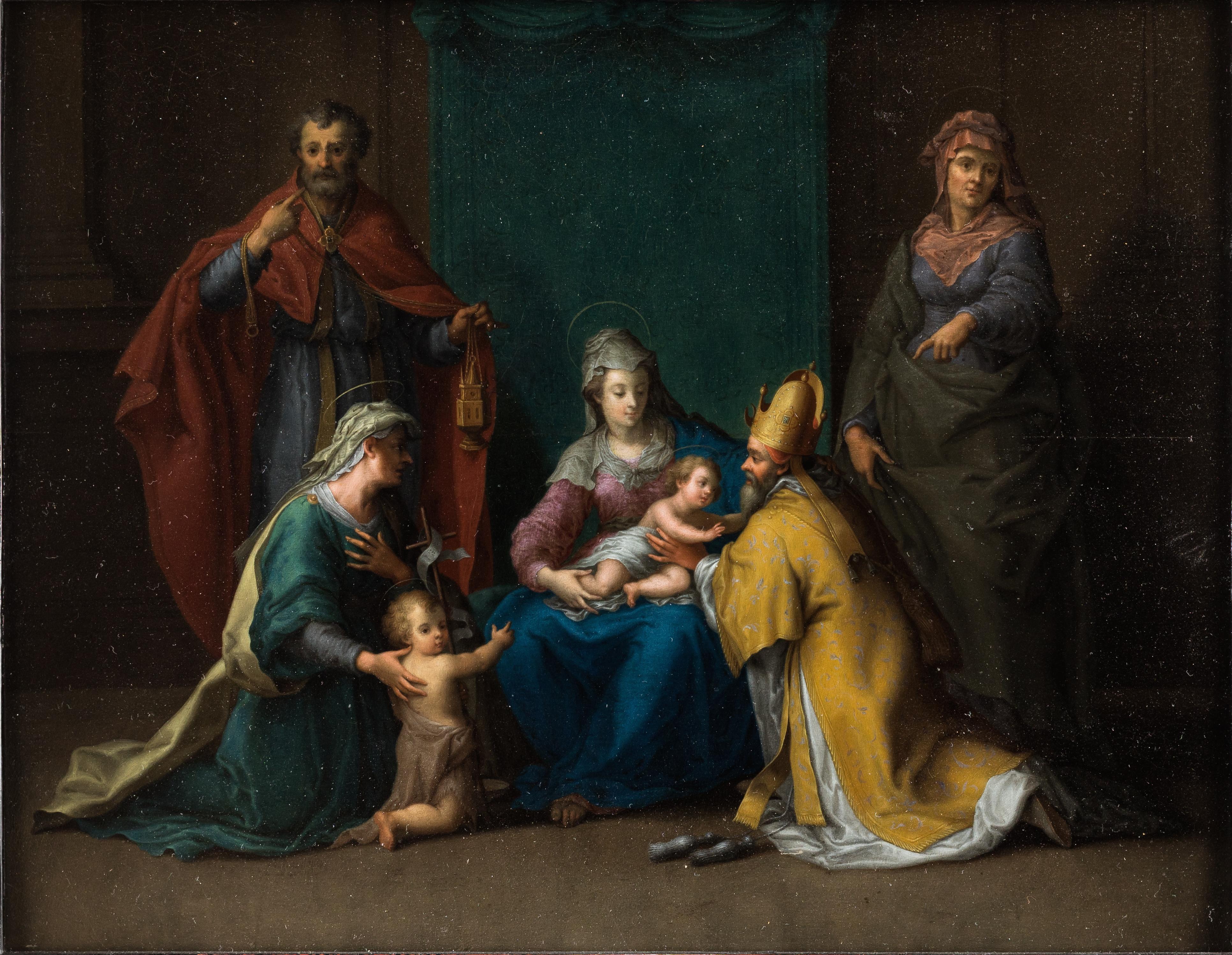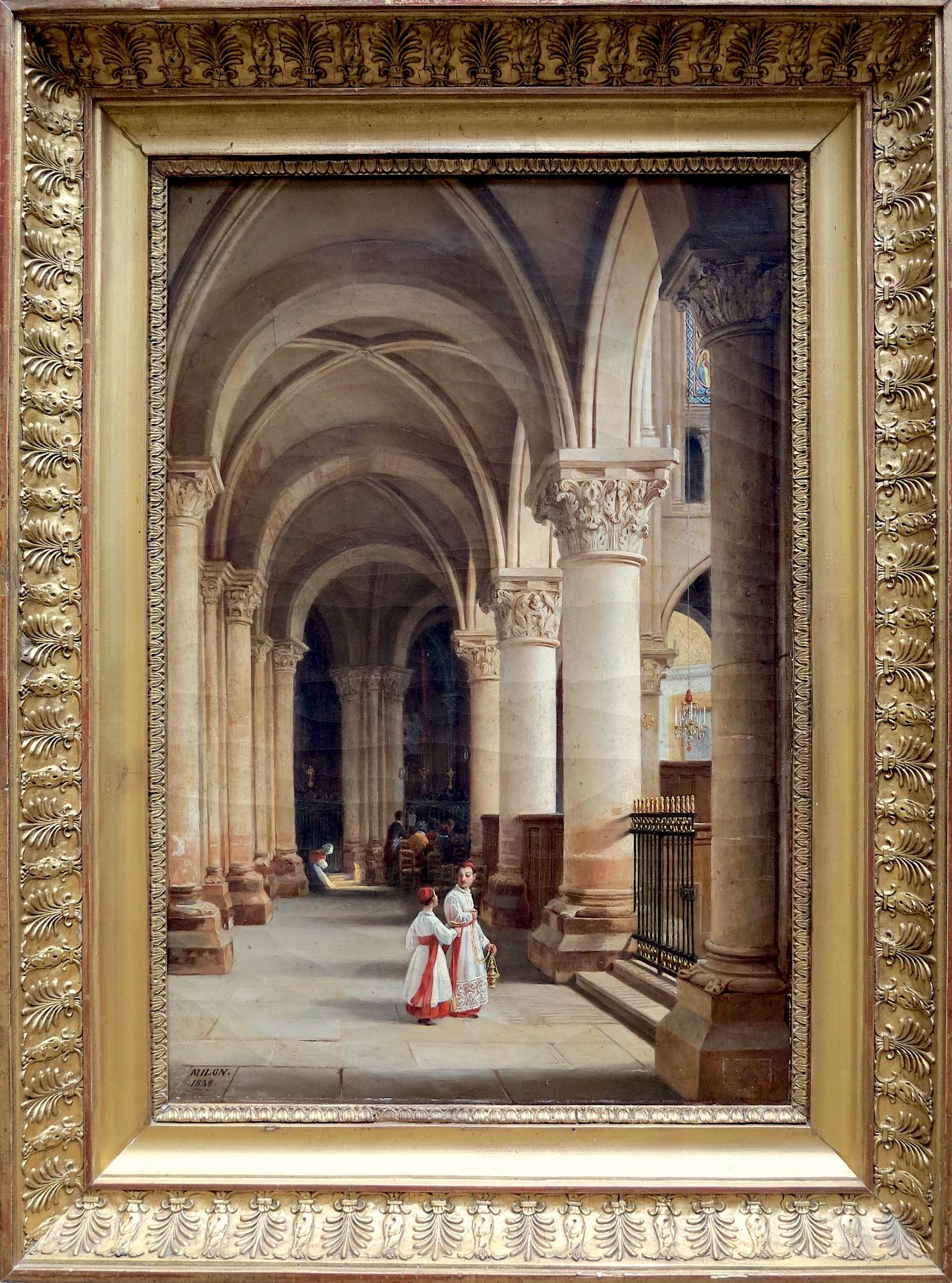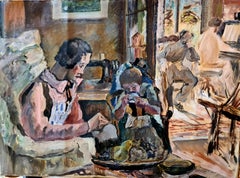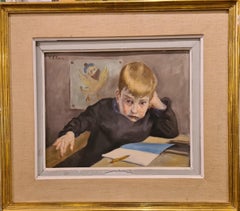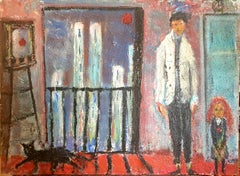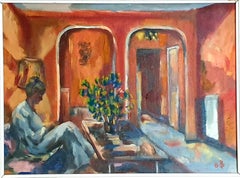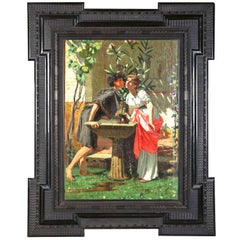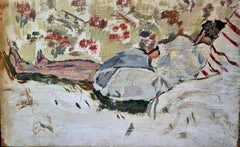
French Mid Century Oil on Board, Interior, The Siesta, Circle of Henri Matisse
View Similar Items
Video Loading
Want more images or videos?
Request additional images or videos from the seller
1 of 8
Léon NanceyFrench Mid Century Oil on Board, Interior, The Siesta, Circle of Henri Matisse1940s
1940s
About the Item
- Creator:Léon Nancey (1893 - 1972, French)
- Creation Year:1940s
- Dimensions:Height: 7.88 in (20 cm)Width: 13 in (33 cm)
- Medium:
- Period:
- Condition:Paint loss to the corners of the board.
- Gallery Location:Cotignac, FR
- Reference Number:Seller: LG/Nancey/Siesta1stDibs: LU1430215723762
About the Seller
5.0
Platinum Seller
Premium sellers with a 4.7+ rating and 24-hour response times
Established in 2000
1stDibs seller since 2020
242 sales on 1stDibs
Authenticity Guarantee
In the unlikely event there’s an issue with an item’s authenticity, contact us within 1 year for a full refund. DetailsMoney-Back Guarantee
If your item is not as described, is damaged in transit, or does not arrive, contact us within 7 days for a full refund. Details24-Hour Cancellation
You have a 24-hour grace period in which to reconsider your purchase, with no questions asked.Vetted Professional Sellers
Our world-class sellers must adhere to strict standards for service and quality, maintaining the integrity of our listings.Price-Match Guarantee
If you find that a seller listed the same item for a lower price elsewhere, we’ll match it.Trusted Global Delivery
Our best-in-class carrier network provides specialized shipping options worldwide, including custom delivery.More From This Seller
View AllFrench Mid Century Oil on Canvas, Interior, La Famille, Circle of Henri Matisse
Located in Cotignac, FR
French mid century oil on canvas of a family in an interior scene by Léon Nancey. Though not signed the painting was acquired directly from the artists atelier.
This painting beaut...
Category
Mid-20th Century Figurative Paintings
Materials
Canvas, Oil
Donald Duck and Le Petit Ecolier, Early 20th Century Oil on Board.
Located in Cotignac, FR
Early 20th century oil on board portrait of a young schoolboy 'Le Petit Écolier', with Donald Duck, by Pierre Villain (French, 1880-1950). Signed top ri...
Category
Early 20th Century Realist Figurative Paintings
Materials
Oil, Board
$725 Sale Price
48% Off
Large Expressionist Oil on Canvas, Apartment Interior and Cityscape. Oil.
By Ernst Ludwig Kirchner
Located in Cotignac, FR
A mid century Expressionist oil on canvas of a man, child and cat in an interior with a cityscape beyond. The work is not signed but there are various notations to the top rear stret...
Category
Mid-20th Century Expressionist Figurative Paintings
Materials
Oil, Canvas
$2,232 Sale Price
20% Off
Late Mid Century Interior Scene, A Villa at Cannes, South of France. Oil, Board
Located in Cotignac, FR
Late 20th century oil on board of an interior scene with seated female figure by Bill Brown. Initial signed and dated 76 bottom right and titled to the reve...
Category
1970s Modern Figurative Paintings
Materials
Oil, Board
Ecole de Paris, Post Impressionist Portrait of a Mother and Child
Located in Cotignac, FR
Mid 20th Century oil on canvas portrait of a mother and child by the noted Franco Spanish artist Pere Modesto Luis Creixams. The painting is signed bottom left and presented in a very fine patinated wood frame.
This vibrant painting portrays an intimate moment between a mother and her child, capturing the depth of their bond. Creixams employs a dynamic palette of blues, greens, and warm earthy tones, creating a harmonious contrast that emphasizes the tenderness of their connection. The mother, clad in a vivid, multi-hued garment, appears to be in motion, her gentle gaze focused intently on the child cradled in her arms. The child, painted with delicate brushstrokes, mirrors her affectionate expression. The background features abstract floral and geometric shapes, adding depth and complexity. The expressive use of brushwork and colour conveys emotion, movement, and warmth. This painting stands as a timeless celebration of maternal love and the nuances of human emotion. Its captivating composition invites viewers to engage with the serene yet dynamic energy of the scene.
Pere Créixams (9 November 1893 – 1965) was a Spanish painter and illustrator.
A figurative and self-taught painter, his work reflects both the sources of the School of Paris and Catalan painting. Throughout his life, he divided his time, between Spain, his native country, and France, his adopted country.
Pere Créixams began his studies at the Escuela Moderna (the Modern School).
He travelled in 1917 to Paris, in Montparnasse. He made his debut with François Bernouard, at La Belle Édition in 1917. The meeting with the writer Florent Fels was decisive. He introduced him to all of intellectual Paris: the poet, art critic and writer André Salmon who nicknamed him Pierre the Printer, the Swiss writer Blaise Cendrars, Max Jacob, André Malraux, Raymond Radiguet, André Salmon and the painter Amedeo Modigliani.
Creixams continued his art under the advice of the painter Othon Friesz and it was the time of his first successes. He exhibited in 1921 at the Café du Parnasse and at the Galerie Montaigne in Paris. His portraits of women are marked by the style of the illustrious representative of the School of Paris, Amedeo Modigliani.
Florent Fels introduced him to the famous Parisian art dealer Paul Guillaume, who was located at 39, rue La Boétie. The latter offered to sign a contract to commit to delivering all his artistic production to him from November 1921 to June 1922. Creixams' paintings are exhibited alongside those of André Derain, Pablo Picasso, Maurice de Vlaminck, Henri Matisse and Amedeo Modigliani...
Subsequently, Creixams worked with the gallery owner Pierre Loeb with whom he signed a contract in 1925. Located at the corner of Rue de Seine and Rue des Beaux-Arts, the famous Pierre Gallery which, from 1927 to 1963, represented many artists who marked the twentieth century (Braque, Klee, Chirico, Derain, Dufy, Gromaire, Léger, Miro, Pascin, Picasso, Soutine, Masson, Man Ray...)
In painting, he turned to his Spanish ancestors, El Greco, Francisco de Goya, Diego Velázquez in order to affirm their artistic heritage. His admiration for Pablo Picasso was also felt in his production of the 1920s and he learned the lesson of the painter of the poor, the acrobats and the guitarists.
From 1922, he settled in Montmartre and frequented the former members of the Bateau-Lavoir such as Pablo Picasso, Max Jacob, André Salmon. His friends in Florent Fels' literary circle supported him and Creixams then became friends with writers. The painter became an illustrator and collaborated with the writer and publisher duo Pascal Pia and René Bonnel on the unpublished poem by Charles Baudelaire, published from the original manuscript, which he adorned with eight etchings.
In 1928, he exhibited at the Salon d'Automne and also took part in the Salon des Indépendants and the Salon des Tuileries.
Creixams made a name for itself by exhibiting in Parisian galleries and salons. (Salon des Indépendants, Salon d'Automne, Salon des Tuileries). In Paris, he befriended Catalan artists, like him exiled, or staying in the French capital, such as Joaquín Torres García, Eugenio d'Ors and Joan Miró. In Barcelona, in the same way, Creixams maintained friendships. His meeting with the critic and painter Rafael Benet opened the doors to the Barcelona artistic world. Creixams was a total success: he was presented in the city's avant-garde galleries, in salons and his works attracted the eye of collectors (Galeríe Dalmau, Sala Parés, Syra Art Galleries). He exhibits his works regularly at the Exposició de Primavera [Spring Exhibition], Saló de Montjuïc.
Creixams' painting was first inspired by the Catalan noucentista. This movement, which began around 1906 and lasted until the beginning of the civil war in 1936, was artistic and political and proposed a renewal of society. Eugenio d'Ors, the theoretician of this new aesthetic, wanted an artistic regeneration in Catalonia. Then Creixams quickly evolved towards a popular and direct realism claimed by the new generation of artists called Generació del 17. His landscapes are very constructed, geometrized, the result of a great admiration for Paul Cézanne.
Creixams' attachment to his country was manifested in regular visits to Catalonia throughout his life. The summer period was privileged and the small fishing village of Tossa de Mar welcomed the artist during many stays. These returns to Catalonia bring Creixams a new inspiration and a more personal style. Tossa, a haven of peace and a site of great beauty, became a real artistic and intellectual centre under his leadership. Creixams and Benet brought with them their Catalan friends: Emili Bosch Roger, Francesc Camps Ribera, Josep Gausachs, Francesc Domingo, Josep Mompou, Manuel Humbert, Emili Grau Sala, Enric Casanovas. But the attraction went beyond the Catalan borders thanks to the knowledge of the artist who invited his Parisian friends, writers, led by Florent Fels, Georges Charensol, Georges Duthuit and artists such as Albert Marquet, Roger Wild, Georges Kars and Marc Chagall.
After spending the summer of 1934 in Tossa in the company of many artists, Creixams did not return to Paris and remained in Catalonia until 1937. In fact, he was appointed professor at the Escola Superior de Paisatge d'Olot. Then came the year 1937, marking a historical and political turning point for Catalonia and Spain. Creixams is artistically committed to the Republicans. It was at that time that the Catalan government chose him to illustrate a propaganda work published by the Commissariat de Propaganda de la Generalitat.
He experienced the first armed clashes in Barcelona, but finally, as the situation deteriorated, he returned to live in Paris on February 20, 1937. He left Catalonia in the middle of the civil war and only returned after an eleven-year exile. Following his committed drawings, in 1939 he produced canvases illustrating the Retirada depicting the flight to France of thousands of Spanish Republicans.
This return to France, during the Second World War, and the period of the Occupation were difficult. But Montmartre once again welcomed him with open arms and Creixams met up with his friends from the Butte, writers, painters and songwriters. He then became an essential figure in Montmartre alongside Marcel Aymé, Pierre Mac-Orlan, Gen Paul among others. The traditional party atmosphere that reigns in Montmartre suits the bon vivant character of Creixams perfectly. The distance from his native country for several years resulted in a painting with deep Spanish accents.
Creixams,in 1938, again participated in the various Parisian salons. In addition, he exhibits as a Montmartre artist in group exhibitions but also alongside his Catalan compatriots. Regular solo exhibitions are devoted to him by Parisian galleries. (Delpierre Gallery, Petridès Gallery, Élysée Gallery, Charpentier Gallery...)
Around 1940, Creixams met Nana de Herrera (1905-1991) and from their love was born a child, Ramon de Herrera. Nana de Herrera, a major figure in Parisian social life during the Roaring Twenties, is a Spanish classical ballet dancer. She was the model for Max Ponty for his design of the famous Gitanes cigarette packet (from the Seita). She also played a few film roles, both before and after the war. It is famous, among other things, for the portrait made by Tamara de Lempicka...
Category
Mid-20th Century Post-Impressionist Figurative Paintings
Materials
Canvas, Oil
Post Impressionist Bar Scene, Le Cafe du Commerce, Oil on Board
Located in Cotignac, FR
Early 20th Century oil on board interior bar scene by Simon Joseph Simon-Auguste. The painting is signed bottom right and presented in a fine gilt carved wood Montparnasse frame. The...
Category
Mid-20th Century Post-Impressionist Figurative Paintings
Materials
Oil
You May Also Like
Italian Oil on Alabaster Painting Pompeian Interior Scene in Ormolu Frame
Located in Firenze, IT
This Italian 19th century oil on alabastrer painting depicts an opulent interior in full ancient neoclassical Pompeian style with people festing.
The figurative inner scene is painted on a rectangular alabaster slab and housed in a wonderful giltbronze frame resting on casted arrow feet.
This is a single section of a bigger surtout de table. You can now use it as a decorative centrepiece on a table or on a console or turn it into a wall decoration. We can provide framing options in this case.
The characters enjoy a rich banquet in an elaborate interior, the room renderings...
Category
19th Century Italian School Interior Paintings
Materials
Alabaster, Bronze
Lovers at the Fountain - Italian 19th Century Figurative Oil on Canvas Painting
By Modesto Faustini
Located in Rome, IT
Amanti alla Fontana - Lovers by a fountain, painting oil on canvas,
Signed left sight.
Measures: cm 70 x 100 frame 118 x 145
Faustini Modesto. Brescia, 27 maggio 1839 - Roma, 23 m...
Category
Mid-19th Century Romantic Figurative Paintings
Materials
Oil
18th century oil sketches for a Baroque interior - a pair
Located in London, GB
A FEAST OF THE GODS WITH VENUS AND BACCHUS
Collections:
With Appleby Brothers, London, June 1957;
Hazlitt, Gooden & Fox, London, 1961;
John and Eileen Harris, acquired from the above, to 2015.
Literature:
Jacob Simon and Ellis Hillman, English Baroque Sketches: The Painted Interior in the Age of Thornhill, 1974, cat. no.12 (as by Louis Laguerre);
Elizabeth Einberg (ed.), Manners and Morals: Hogarth and British Painting, 1700-1760, exh. cat., London (Tate Gallery), 1987, cat. no.10 (as by Louis Laguerre);
Tabitha Barber and Tim Bachelor, British Baroque: Power and Illusion, exh. cat., London (Tate Britain), 2020.
Exhibited:
Twickenham, Marble Hill House, English Baroque Sketches: The Painted Interior in the Age of Thornhill, 1974, no.12 (as by Louis Laguerre);
London, Tate Gallery, Manners and Morals: Hogarth and British Painting, 1700-1760, 1987, no.10 (as by Louis Laguerre);
London, Tate Britain, British Baroque: Power and Illusion, cat. no 92, 2020.
CUPID AND PSYCHE BEFORE JUPITER
Collections:
With Appleby Brothers, London, June 1957;
Hazlitt, Gooden & Fox, London, 1961;
Anthony Hobson, acquired from the above, to 2015.
These recently re-united paintings are the most ambitious surviving baroque ceiling sketches made in Britain in the early eighteenth century. From the Restoration until the rise of Palladianism in the 1720s decorative history painting formed the preeminent artistic discipline in Britain. It was a field dominated by Continental artists including the Italian Antonio Verrio and the Frenchmen Louis Laguerre and Louis Chéron...
Category
Early 18th Century Baroque Figurative Paintings
Materials
Canvas, Oil
VAN BIESBROECK Jules. Snake charmer. Oil on panel. Signed.
By Jules Pierre van Biesbroeck
Located in Paris, FR
Algerian women in an interior. Oil on panel. Signed.
This work will be recorded in the catalogue raisonné of the work of the artist currently in preparation.
Jules Van Biesbroeck...
Category
1920s Figurative Paintings
Materials
Oil
VAN BIESBROECK Jules. Algerian women in an interior. Oil on panel. Signed.
By Jules Pierre van Biesbroeck
Located in Paris, FR
Algerian women in an interior. Oil on panel. Signed.
This work will be recorded in the catalogue raisonné of the work of the artist currently in preparation.
Jules Van Biesbroeck w...
Category
1920s Figurative Paintings
Materials
Oil
An auction at Drouot's in Paris.
By René Francois Xavier Prinet
Located in Paris, FR
An auction at Drouot's in Paris.
Oil on canvas. Signed lower right.
Around 1900-1910.
René François Xavier Prinet (31 December 1861, Vitry-le-François – 26 January 1946, Bourbonne-les-Bains) was a French painter and illustrator who drew his subjects from middle-class society.
He was born to Henri Prinet, an Imperial Prosecutor in Vitry-le-François. A promotion led to him being posted in Paris, where they lived in a home not far from the École Nationale Supérieure des Beaux-Arts. His father painted as a hobby and was supportive of his desire to study art, having him seek the advice of Louis Charles Timbal [fr], a well-known church painter and friend of the family.
Around 1880, he began his studies in earnest, in the studios of Jean-Léon Gérôme; remaining with him until 1885. That year, his painting "The Infant Jesus" was accepted for display at the Salon. This was followed by studies at the Académie Julian. At this time, he also became associated with a group of young artists known as the Bande Noire (Black Stripe), which included Lucien Simon, André Dauchez...
Category
Early 1900s Realist Figurative Paintings
Materials
Oil
Recently Viewed
View AllMore Ways To Browse
Portrait Painting Man In Suit
Rabbi Lithograph
Red Cross Poster
Robert Indiana American Dream
Salvador Dali 1968
Saul Steinberg Lithograph
Steve Mccurry India
Sultan Of Oman
T Powers
Vintage Anarchist Art
Vintage French Beach Posters
Vintage Herb Prints
Vintage Photography Props
Warhol Campbell Soup Print
1980 Olympics Poster
Agam Hand Signed
Albrecht Durer Etchings
Cheese Painting
